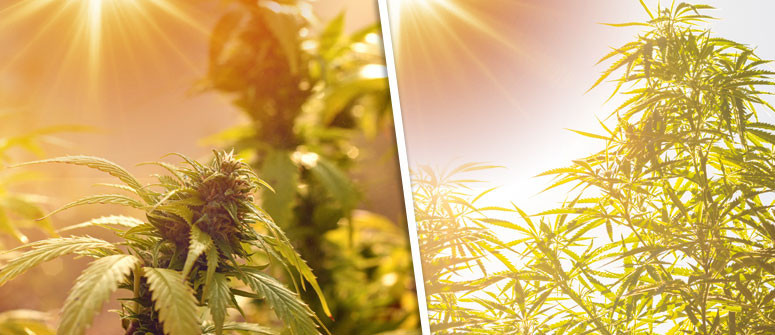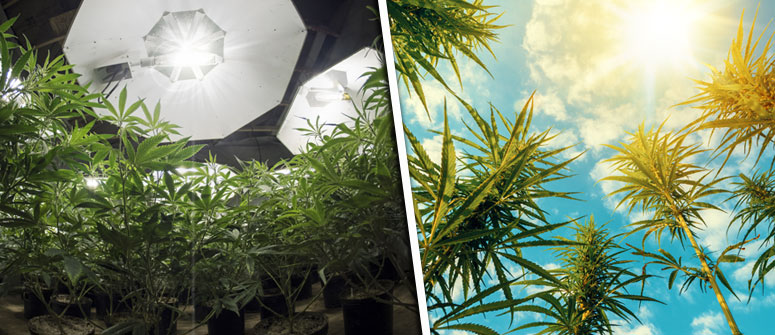Understanding cannabis plants photoperiod

Cannabis is a photoperiodic plant. This means they respond to changes in day length. More specifically, photoperiod dependent plants will react differently to alterations in their light cycle, which changes throughout the year.
Cannabis is a photoperiodic plant. Photoperiodic plants basically just respond to changes in day length. More specifically, photoperiod dependent plants will react differently to alterations in their light cycle, which changes throughout the year. For instance, summer days are typically longer in daylight hours than winter days in the Northern Hemisphere.
Cannabis plants have a very noticeable response to photoperiod changes. As the days become shorter towards the end of summer/beginning of autumn, the plant receives less and less sun (hours). This causes the plant to realize that its life cycle is coming to an end and because of this both female and male cannabis plants will start to flower in order to reproduce before winter.
Male cannabis sacs will open to release pollen into the atmosphere, which, at least in nature, will ideally pollinate the female flowers, causing them to produce seeds. These seeds will then spread and germinate after winter is over, giving birth to the next generation of plants.
Photoperiodism isn’t unique to cannabis plants. Many flowering plants use photoreceptor proteins to sense seasonal changes in the length of night and day in their environment. They then interpret those changes as signals for when to flower.
Some plants, similar to cannabis, will flower once the daytime hours become shorter. These are known as “short day plants.” Long day plants like carnations, peas, and wheat, for example, will flower when the days become longer (spring or summer in the Northern Hemisphere).
Other plants are day neutral. Roses, cucumbers, and tomatoes will not flower based on the photoperiod in their environment. Instead, they may flower once they get to a specific age, following a sudden change in temperature, etc.
WHAT DOES PHOTOPERIOD MEAN FOR CANNABIS GROWERS?

Photoperiod is a big deal for cannabis growers as it dictates when your plants will flower. As mentioned earlier, cannabis plants growing in the wild or in an outdoor garden will naturally start to flower at the end of summer (around August/September in the Northern Hemisphere and March in the Southern Hemisphere).
Now, cannabis isn’t always grown outdoors. In fact, ever since it first became illegal, growers have largely moved their marijuana gardens indoors to avoid arousing suspicion or catching the attention of law enforcement.
Since about the 1980s, the world of cannabis has been undergoing an “indoor boom.” Thanks to better equipment and huge advancements in breeding, it became much easier to grow cannabis plants indoors (which, given the illegality of marijuana, was a huge plus for growers).
Obviously, indoor growers have to use grow lamps instead of sunlight to grow their plants. The basics of indoor growing involve leaving plants to “veg” (undergo vegetative growth) with anywhere upwards of 16 hours of light per day, before driving down light hours to force plants to flower.
Indoor growers have all kinds of different techniques for growing their plants, but most beginners will start off using an 18-6 light-dark cycle for the vegetative period, before moving to a 12-12 light-dark cycle for flowering.
This means that an indoor grower fully controls when the plants are in their vegetative and flowering period. In the beginning, during the vegetative growth, the lights should be turned on for 18 hours/day and 6 hours of darkness/day. When the grower wants the plants to start their flowering period the amount of light is decreased to 12 hours of light/day and 12 hours of darkness/day.
WHAT ABOUT AUTOFLOWERING STRAINS?
In recent years, cannabis seedbanks and breeders have developed “autoflowering strains.” These strains contain genetics from Cannabis ruderalis, a unique cannabis variety discovered in Siberia that flowers based on age, rather than photoperiod.
Unlike regular cannabis strains, autoflowering strains will flower after a certain amount of time. This makes them particularly interesting to outdoor growers who're interested in multiple crops per year. If you start early in the season you can already harvest your first crop after 7-8 weeks. Just take care you're ready for round two.
.jpg)
.jpg)

.jpg)
